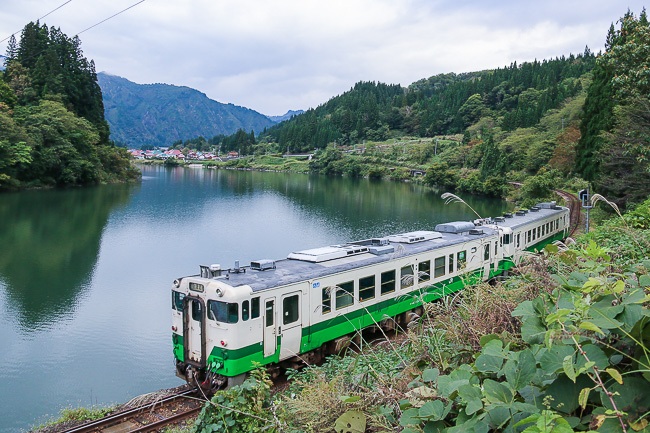Following the Tadami Line in Oku Aizu
by Raina, staff writer of japan-guide.com
| previous post |
| next post |
2016/10/11 - Following the Tadami Line in Oku Aizu

The Oku Aizu region in the far west of Fukushima Prefecture is a mountainous region covered mostly by forest. Oku Aizu is roughly about the same size as Kanagawa Prefecture near Tokyo, but only has a population of 19,000 (compare that to the 9 million people living in Kanagawa Prefecture!). There are no major international chain stores like McDonald's and Starbucks to be found in Oku Aizu, and neither are there 24-hour convenience stores. Being such a remote place also means that there are lots of secret hideouts waiting to be discovered, and that was what I set out to do.
One of the most well known attractions in Oku Aizu is the JR Tadami Line, which runs from Aizu-Wakamatsu Station to Koide Station in Niigata Prefecture. This local train line follows a scenic route over rivers and through forests, making it a favourite among train fans. The Tadami Line was also ranked amongst one of the top five most scenic and picturesque lines, allowing passengers to enjoy beautiful landscapes during the different seasons. However, since 2011, travellers cannot take the entire line from end to end, as heavy rains caused three bridges to collapse and weakened the infrastructure of another. Currently, the section between Aizu-Kawaguchi and Tadami remains out of service, and substitute buses run between the stations instead.

Despite the reduced route, the scenery along the Tadami Line is very beautiful and continues to wow travelers. During winter, the Oku Aizu region sees a lot of snow and some of the roads get closed. But the Tadami Line stays open, allowing for transportation between Oku Aizu and Niigata during the snowy months. It seems that if more people take the train, plans to rebuild the broken section may be expedited, and travelers can look forward to uninterrupted rail travel.
For this trip, I took advantage of the Oku Aizu Taxi Plan to get around the region. The plan provides large savings over hiring a regular taxi and works out to be one of the cheapest ways to get around without having to drive. The taxis are mini vans and can accommodate up to nine people. Visitors can take the taxi between Niigata Airport or selected train stations in Fukushima into the Oku Aizu region, with the option of renting the taxi for a day of sightseeing at an additional 3000 yen per person and day. Reservations for the taxi service can be done online in English.
I was picked up at Koriyama Station, and from there it took about 1.5 hours to get into the Oku Aizu region. My first stop of the day was the Fukuman Kokuzo Bosatsu Enzoji Temple (typically shortened to Enzoji Temple). The temple's history goes back over a thousand years, but the current temple building is from the late Edo Period, and is the biggest temple in Fukushima Prefecture. The original temple (which had a wooden stage resembling the one at Kyoto's Kiyomizudera) was said to have been built with the help of mythical red bulls (akabeko), who carried the materials used for the construction of the temple. From then, Enzoji Temple became known as the birth place of the akabeko cows that are well known all across the country and the symbol of the Aizu Region.




Enzoji Temple is also the location for a number of local events. One of them occurs on January 7 when local men dressed in traditional underwear (fundoshi) attempt to scale the five meter rope used to sound the gong. Another is a ceremony for children when they reach thirteen years of age, to pray for wisdom.




Moving on, I participated in a number of activities available in the region. The first of the two was vine weaving. Woven vine bags were originally made to hold tools used in the mountain, but have since become luxury items. Smaller accessories are quite affordable, but larger bags and baskets take a longer time to create, and prices start from about 50,000 yen for the smaller bags. These woven products virtually last forever and like fine wine, improve with age. I learned that the bigger bags are mostly made to order and passed down from generation to generation.


The second of my hands-on activity was candle making. It was my first time to make a candle using beeswax, and doing so inside a traditional house also made it a little special. I started off thinking that it would take forever for the candle to reach a decent size, but the entire process only took about 40 minutes from start to finish. Not too bad indeed.





One of the best ways to experience the Oku Aizu region (or anywhere really) is to stay over, and that was what I did. I spent the night at Ebisu-ya, a local family-run ryokan in the Tamanashi Hachimachi area. The special thing about the hot spring baths in the area is that they are naturally bubbly. Carbonated springs are the rarest of all the eleven types of hot springs found in Japan, and many of them lose their bubbly feature when cooled down or heated up to bathing temperature. But the ones at the public hot spring Seseragi-so just across the river from the Ebisu-ya ryokan are of a good temperature and almost instantly create bubbles on the skin of bathers. Needless to say, I enjoyed the baths and the food at Ebisu-ya, just what I needed after a day of sightseeing.





The next day, I continued my journey, stopping at some of the unused train stations along the Tadami Line. It was amazing to see how Mother Nature had taken over the past five years but also a little sad as it would've been a great train ride passing through all the different landscapes.
I wasn't long before I found myself at a naturally carbonated spring. Unlike the carbonated baths from the night before, the bubbling water here was cool to drink and had a slightly metallic taste. It was quite unusual to see and hear the water bubbling away yet was cool to the touch. Nearby the well was Harves, a company which processes and bottles the naturally carbonated water. The company removes excess iron and magnesium in the water to make the water more palatable. I found out that sparkling water produced by Harves was served to the guests at the G7 Summit in Ise Shima in 2016. The water is naturally carbonated, soft water which was evident in its taste (not as strong compared to other popular brands of carbonated water).



On the way to my next destination, I stopped by Tagokura Dam, one of the three largest dams in Japan in terms of reservoir volume. The dam and lake are surrounded by many beech trees and is said to be extremely beautiful once the autumn colors set in. From there, I went to Yurari Hotel, one of the biggest hotels (if not the biggest) in the Oku Aizu region. The 20-room facility has a huge banquet room as well as conference rooms, a restaurant-cafe and hot spring baths. The hotel also has a separate hot spring area for day-use with a casual restaurant. I checked out the hot spring and also managed to catch the restaurant ladies making lunch, before getting some myself.




My final stop in Oku Aizu was the Maezawa Furusato Park, a collection of about 25 traditional, thatched roof houses. The L-shaped houses are specially designed and adapted to suit the cold and high snowfall the area receives. The toilets and horse stables were located in the houses' short ends, while the longer sides made up the living quarters. The location of the houses were quite hidden in the valley and quite purposely so, as the original settlers were on the run and did not even own dogs or roosters, or anything that could give their location away. These days however, it isn't too difficult to get to Maezawa Furusato Park as it is just off the national route 352.
I walked around the park and saw beautiful seasonal flowers and vegetable patches, as well as some recreations of how the villagers used hydropower to mill their rice. The main stream that runs down the length of the village was used for daily living. The water at the top of the stream was for drinking, followed by cooking, and the bottom was typically used for rinsing the dirtiest items. These days, the stream is used for chilling drinks and fruits in the summer and watering the vegetable gardens.
Of all the houses, only one can be entered and toured as the rest remain private homes. The main thing about the homes were their roofs. Back in the day, the thatched roofs were changed every 30 to 40 years, a process which took a long time, and also doubled as training for future roof apprentices. Changing a roof involved the entire community, and payment for labor was often in the form of food and drink. These days, it costs about 20 million yen to change a single roof, as the number of roof specialists are getting far and few in number. As a result, not many people change their entire roof, and only a portion of it is changed if they have to.





With that, I ended my tour of Oku Aizu thinking about the lifestyles of those who lived in remote places. The region has a lot to offer all year, and even though I went in early autumn, there was lots to do still. The coming winter will offer a whole different spectrum of activities, like skiing and snowboarding, and wintry landscapes like those that can be found in Finland. I'm already looking forward to going back and next time taking the Tadami Line as far as I can for a romantic slow travel, and to see the scenery that made lots of people fall in love with the region.

| previous post |
| next post |


